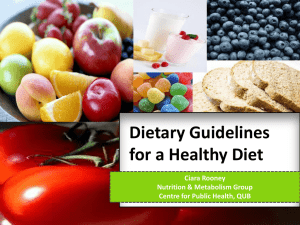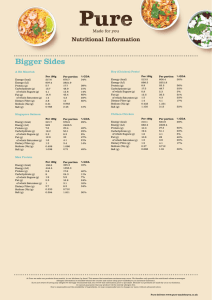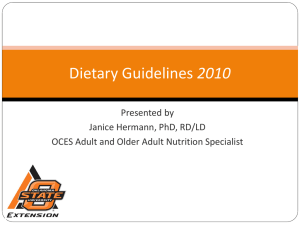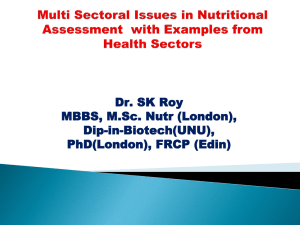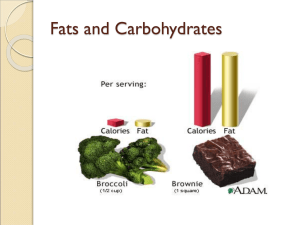healthy eating
advertisement
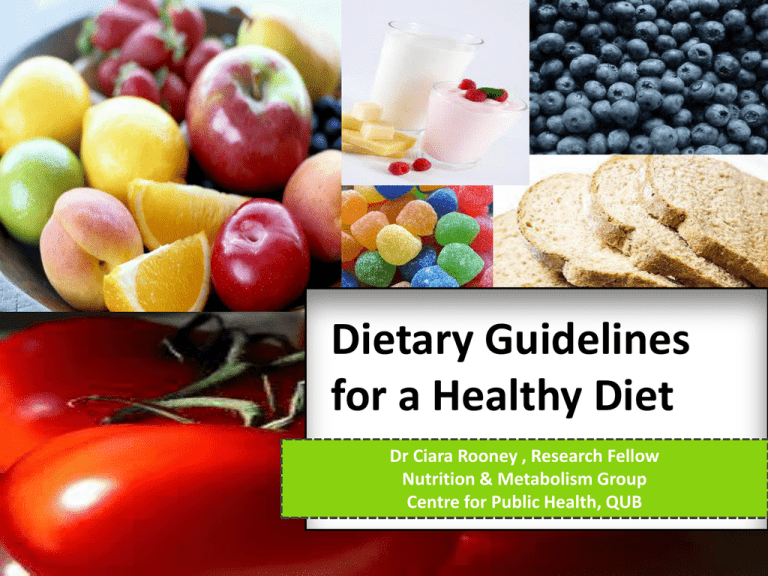
Dietary Guidelines for a Healthy Diet Dr Ciara Rooney , Research Fellow Nutrition & Metabolism Group Centre for Public Health, QUB What are dietary guidelines? • A healthy diet is important for overall health • The amount and types of food eaten has a major influence on health • Hence, nutritional/dietary intake guidelines have been devised Nutritional requirements • The amount of each nutrient needed is called a nutritional requirement • Nutritional requirements vary between individuals and life stages Nutritional requirements Energy requirements are lower than in adolescence Lower requirements for calcium & phosphorus after adolescence Reduced requirement for magnesium in women Requirements during pregnancy & lactation change ADULTS 19 - 50 years Reduced requirement for iron in men However, selenium requirements increase slightly for men Requirements for protein, vitamins & minerals mostly unchanged from adolescence Nutritional requirements Energy requirements decrease after 50 years in women and 60 years in men Protein requirements decrease in men Nutrient density even more important at this stage OLDER ADULTS Recommended that older adults take 10µg/day vitamin D supplement 50 years + Protein requirements increase in women Requirements for vitamins and minerals mostly unchanged Except iron – after menopause women’s requirements reduce Nutritional requirements Energy Requirements MALES FEMALES (kcal) (kcal) 19-24 years 2772 2175 25-35 years 2749 2175 35-44 years 2629 2103 45-54 years 2581 2103 55-64 years 2581 2079 65-74 years 2342 1912 75+ years 2294 1840 ADULTS Guideline Daily Amounts = Males: 2500kcal/day Females: 2000kcal/day Nutritional requirements Nutrient requirements Macronutrient Dietary Reference Value Total fat Population average no more than 35% food energy Saturated fatty acids Population average no more than 11% food energy Trans fatty acids Populations average no more than 2% food energy Total carbohydrate Populations average no more than 50% food energy Non-milk extrinsic sugars (NMES) [added sugars] Population average no more than 11% food energy Non-starch polysaccharides (NSP) [fibre] Adult population average at least 18g per day Salt Adult population average no more than 6g/day Putting this information into practice HIGH OR LOW?! Total fat •High: more than 17.5g of fat per 100g •Low: 3g of fat or less per 100g Saturated fat •High: more than 5g of saturated fat per 100g •Low: 1.5g of saturated fat or less per 100g Sugars •High: more than 22.5g of total sugars per 100g •Low: 5g of total sugars or less per 100g Salt and sodium •High: more than 1.5g salt per 100g (or 0.6g sodium) •Low: 0.3g salt or less per 100g (or 0.1g sodium) http://www.nhs.uk/change4life/Pages/food-labels.aspx The eatwell plate Fruit and vegetables • What counts? • Eat plenty (should make up one third of daily food intake) • Eat five portions per day • Eat a variety • Why?: vitamins, minerals, fibre But what’s a portion?… 2 1 0 1 2/3 Starchy carbohydrates • What counts? • Eat plenty (should make up one third of daily food intake) • Aim for at least one food from this group at each meal • Choose wholegrain varieties if possible • Why?: carbohydrates (main source of energy), fibre, some calcium, some iron, B vitamins, folate Practical tips to eat more starchy foods Breakfast Lunch Dinner Meat, fish & alternatives • What counts? • Eat moderate amounts – red & processed meat 70g/day max • Aim to eat two portions (140 g) oily fish/week • No limit for eggs – eat in moderation • Why?: protein, iron, B vitamins (especially vitamin B12), vitamin D, magnesium, omega-3 fatty acids Milk and dairy foods • • • • What counts? Does not include: butter, eggs and cream Eat moderate amounts Serving = 200ml of milk, 150g pot of yogurt, 30g (matchbox size) cheese • Why?: Calcium, zinc, iodine, protein, vitamins B12, B2 and A Fats and sugars • What counts? • Eat sparingly • Some fat essential, but foods with fat can be high in calories • Two essential fats – omega-3 and omega-6 fatty acids • Sugar adds sweetness to foods, but associated with tooth decay How much is enough? Current population dietary intakes NMES (sugar): intakes exceeded requirements for all age groups Vitamins: from food were close to/above requirements Saturated fat : exceeded requirements (19-64 years) Minerals: below requirements in some age groups (particularly 11-18 year olds) Eat well, work well! • We consume at least 1/3 of our daily calorie intake while at work • What we eat affects our health but also work performance • Keep hydrated, bring healthy snacks and a packed lunch 6-8 glasses/day Some take home messages • Start by making small changes – they can make a big difference! • Base food choice on eatwell plate • Remember: balance • Check food labels when shopping • Get active and be a healthy weight • Eat well at work • Avoid getting thirsty • Don’t skip breakfast
